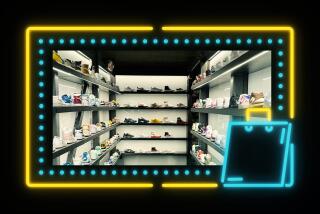Put It on Paper
- Share via
They’d shopped at the tony stationery store for years and were at home on its exclusive street in Santa Barbara County’s tiny Montecito Village. So when a friend mentioned that the owner wanted to sell, the sisters jumped at the chance.
A call to the broker, a loan from the family, and they were in business.
“It’s just one of those things--you turn around the corner and there’s something new you’re doing,” said Julia Postle, co-owner of Stationery Collection. “We weren’t doing a lot of research or contemplation or anything like that.”
They knew that the shop, opened in 1935 as Paul F. Scott, Stationer, at one time catered to hundreds of elite clients in Montecito, Santa Barbara and as far east as the Mississippi River. Afternoon teas, lawn parties, formal balls and receptions, as well as extensive personal stationery collections, are all documented in the copper engraving plates in the store’s archives--glimpses into a more formal era.
For Postle and her sister, Nancy Carr, the store’s long history is a mixed blessing. It can’t hurt that the shop has been on the same street since it opened and has a customer list that goes back decades.
On the downside, the store had been in decline for a number of years as it passed through the hands of several owners. Sales drifted from just more than half a million dollars in 1992 to roughly $250,000 last year, Postle said. The inventory had grown shopworn and literally dusty. Longtime employees were convinced the old clients were dying and that the store’s decline was almost inevitable. The sisters, who bought the store in January, had their doubts too.
“It’s like, how do you do it?” said Postle. “Do you grab any of that [history]? How do you revive something that was once so thriving? It’s a different world now.”
The owners are pinning their hopes on the custom stationery business--the personalized writing papers, invitations, business stationery, etc., that accounts for 32% of sales but 40% of the store’s profit.
“Miss Manners is alive and well in Montecito,” said Postle. “People there are very polite. They always write thank-you notes for everything, and they wouldn’t dream of doing it on stationery that doesn’t have their own personalization on it, whether it’s a crest or a monogram or a name. And you don’t have any sort of dinner function without place cards.”
Winning that business from old customers and attracting new clients will take a concerted effort, warned business consultant Philip J. Borden. A new competitor in the area has already taken some business from Stationery Collection; longtime residents are taking a wait-and-see attitude; and younger customers, if they even know the store exists, may be turned off by a staff unused to dealing with them, he said.
Although marketing is the area the sisters need to work on most, said Borden, executive director of Women’s Enterprise Development Corp. in Long Beach, their efforts should start with the basics: compiling a business plan.
*
Without thinking through the tough questions about money, time and target market demographics, a business owner isn’t prepared for the long haul, he said.
“The problem I see is [the sisters] don’t know how to sustain their efforts from a marketing point of view,” Borden said. “They need to know how much income they can generate and they need to budget for what they are going to spend on marketing and public relations.”
Setting reasonable sales goals is the foundation of a business plan, he said. Postle and Carr, for example, wanted to increase sales about 10% a year, with the goal of doubling revenue to half a million dollars, the former high point, in three years.
“If they had just sat down and done the math, they’d have seen that their own plan wouldn’t get there,” Borden said.
That’s not unusual for small-business owners, who are typically juggling dozens of tasks and creating financial statements on the fly. But thinking through the numbers and how to reach them can be the difference between long-term success and the ash heap of business failure, Borden said.
It’s not that the sisters aren’t business-savvy--they are involved with other family investments and businesses in the area, including property leasing and medical equipment--they just hadn’t devoted the time to a formal business plan, he said.
Doing a break-even analysis as part of that plan will help Postle and Carr determine how much and what mix of products they need to sell to meet their current expenses, including a steep $4,100-a-month rent payment. The analysis will also show what sales and profit levels are needed to reach longer-term goals, and how reducing fixed and variable costs will affect the timetable, Borden said.
Although sales are running about 8% ahead of last year and about even with 1995, the business is still losing money, Borden said. He estimated the operating loss at about $4,500 a month, but he acknowledged that wide fluctuations in monthly sales are common for start-ups.
*
Nonetheless, Borden said, costs need to be cut. The shop, which moved across the street to its current spot five years ago, is probably too large for the business, he said, and relocation should be considered when the lease expires in May. He also suggested the business work to establish credit with its vendors to help cash flow.
“The overhead needs to be controlled at some point,” agreed Postle, but she said the store’s location is one of the primary attractions for the sisters. And commercial sites in the village are scarce.
Moving is “a hard decision to make,” Postle said. “But then Nancy said, ‘Look at these red lines here [on the balance sheet] and you make your choice.’ ”
Another option, said Borden, is to sublease office or even display space in the store to a related business, perhaps a wedding or special-event planner.
In addition to a break-even analysis, the business plan should include analyses of product sales, marketing expenses and a specific marketing plan, Borden said. The sisters need to determine what products make the most money and how to maximize those sales, he said. They’ll need to figure out what the average social printing order is, for example, and how much time it takes to process.
The marketing plan, which should cover two to five years, also needs to start with the basics, Borden said.
“The thing they need most before they do anything else is a consistent image,” he said. “Interestingly enough, we received a fax and a letter [from them] and neither had their store logo or store name. That’s an interesting shortcoming for a stationery store.”
He recommended that the recently hired creative director, a calligrapher, help create materials, including a logo, that reflect “the wonderful quality of the store, because let me tell you, it is a wonderful store,” he said. He also suggested a slogan for the store--”Traditions new and old”--that he said makes a connection not only with the business’ origins, but also “with new folks moving in who don’t know Paul Scott from Adam.”
Expanding the mailing list and sending out new material each month are important ways to establish contact with customers, new and old, Borden said. The store, which is involved in local charities, might ask for a copy of member lists in exchange for contributing services, he said. New marketing material could also be included with each customer’s order, he said. He also suggested establishing ties with local wedding sites and coordinators, bridal shops and hotels in a bid to increase the store’s wedding business, which is minimal.
*
The shop has “an incredible asset” in the form of its old printing dies, Borden said, which could be the key to a unique marketing plan. He suggested setting up rotating displays in the store “almost as a curated museum space,” offering to loan all or part of the die collection to the local history museum, possibly tied to certain holidays, and using a selection of the dies to create the story of a romance, for example, from initial party invitations to an exchange of letters, then an engagement announcement and eventually a baby announcement. That low-key marketing strategy could charm customers while showing them the many ways to use custom stationery printing and keeping the store’s name in front of them.
“It is the single most striking and distinguished characteristic of the store, setting the Stationery Collection apart from its competition,” Borden said. “I think they need to make use of that asset every way that they can.”
The store has been noticed in one unexpected quarter. The owners were recently contacted by a “well-known” stationery store in Los Angeles, inquiring about their interest in selling the spacious shop on East Valley Road. The sisters aren’t interested, at least for now, they said. But the inquiry drove home the importance of the marketing issue.
“It told me there is probably some potential that we are just having a hard time finding,” said Postle.
Cyndia Zwahlen can be reached via e-mail at [email protected]
(BEGIN TEXT OF INFOBOX / INFOGRAPHIC)
Meet the Consultant
Philip J. Borden, a management and technical consultant for 13 years, has been executive director of Women’s Enterprise Development Corp. in Long Beach for two years. His professional experience includes a seven-year stint as president and CEO of Microexpert Systems Inc., a software consulting firm in Los Angeles. He also has taught at UCLA and USC.
(BEGIN TEXT OF INFOBOX / INFOGRAPHIC)
This Week’s Company Make-Over
* Name: Stationery Collection
* Headquarters: Montecito, Calif.
* Type of business: Custom stationers and gift shop
* Status: Sole proprietorship converting to partnership
* Owners: Julia Postle and Nancy Carr
* Financing: $100,000 start-up loan from family business
* Sales: Estimated $250,000 in 1996; 10% increase expected this year.
* Employees: Five part-time
* Founded: 1935; new owners bought the business in January
* Customers/clients: Consumers, professionals and small-business owners who live or have second homes in Montecito or Santa Barbara
*
Main Business Problems
Attracting new customers and reclaiming old customers; high rent
*
Goal
To rebuild annual sales to $565,000 over the next three years
*
Recommendations
* Write a business plan that includes reasonable goals and steps to achieve them.
* Reduce rent, perhaps by subleasing space to a related business or relocating when the lease ends.
* Create a marketing plan that includes expanding the aging, 300-name mailing list; establishing a consistent design approach; and sending monthly mailers that convey the quality and look of the store’s products.
* Take advantage of the marketing potential of the store’s historic printing plates, which document early Santa Barbara and Montecito high society.
More to Read
Inside the business of entertainment
The Wide Shot brings you news, analysis and insights on everything from streaming wars to production — and what it all means for the future.
You may occasionally receive promotional content from the Los Angeles Times.










